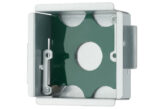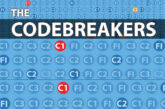
Need help with cracking those EICR codes? The technical team at NAPIT, with the help of the 18th Edition Codebreakers publication, answer your latest coding queries. Click on the photos for a closer look!
STEVEN DOBSON: THIS WAS FOUND ON A RECENT EICR – I’D IMAGINE THAT ISOLATING WILL BE A PROBLEM! ONE OF THE IMAGES SHOWS THE BOTTOM OF THE DB – I’M SURE THE BUSBAR SHOULD BE HERE?!
Every item of equipment is provided with manufacturer’s information, with the more complex sections having a detailed assembly sheet. It’s obvious that this installer didn’t follow such information, which has resulted in a dangerous situation.
This does appear to be an old installation (the plastic consumer unit gives it away), which is all the more worrying as the installation would have been in this state for some time with the client blissfully unaware of the dangers.
In residential premises the double-pole isolator is an essential item of equipment, as it allows a non-technical person to be able to safely isolate the supply. It would also be used for any fire and rescue services to be able to safely isolate when attending an emergency.
So, the double-pole isolator has effectively been bypassed where the busbar has been connected to the incoming line terminal on the top side of the consumer unit along with all the circuit-breakers.
There is excessive copper showing on the connections to the isolator and the circuit breakers. The use of red insulation tape as a means to prevent contact with live parts fails to meet product standard requirements. Although there is exposed live copper busbar on the consumer unit cover, there does not appear to be any unused entry holes or missing blanks, so this would not be considered as a C1.
The most dangerous aspect of this installation is that the isolation of the double-pole main switch will isolate the neutral conductor but not the line conductor, therefore energising the entire installation for the line and neutral conductors. It would provide the impression that the installation was de-energised with the equipment not functioning, but the conductors would still be energised and could cause an eSlectric shock for anyone coming into contact with conductors or terminals.
Therefore, the classification code would be a C1, Danger present – Risk of Injury, immediate remedial action required, for lack of safe isolation, incorrect installation of the link busbar, and a circuit protective conductor not sleeved where exposed live parts are present.
Order your copy of NAPIT Codebreakers here
Catch up on previous Codebreaker articles here









